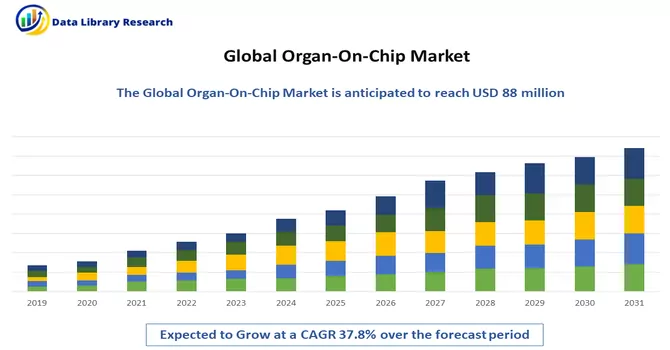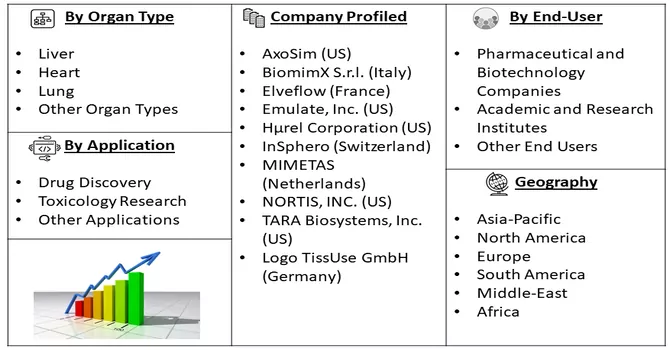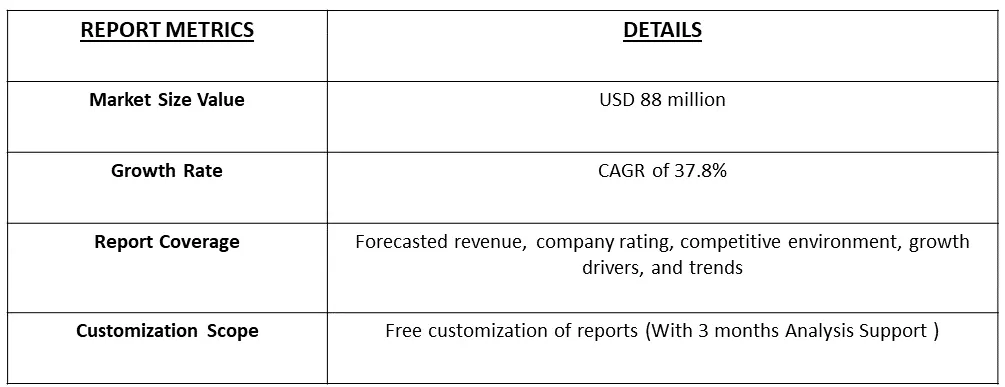The global Organ-On-Chip market is anticipated to achieve a valuation of USD 487 million by 2028, a substantial increase from the estimated USD 88 million in 2022, with a remarkable Compound Annual Growth Rate (CAGR) of 37.8% projected between 2023 and 2030.

Get Complete Analysis Of The Report - Download Free Sample PDF
The Organ-on-a-Chip (OOC) market encompasses the sector involved in the advancement, manufacturing, and commercial distribution of Organ-on-a-Chip technology. Organ-on-chip involves the development of miniature, microscale models of human organs or organ systems with physiological relevance. These microfluidic devices aim to emulate the intricate functions, structures, and responses exhibited by real human organs, thereby creating a more precise and representative environment for a range of biomedical applications.
The primary objective of human organ chips is to serve as advanced tools in drug discovery and toxicology testing, offering a humane alternative to animal models. Traditional animal models pose ethical challenges and often fall short in accurately predicting clinical efficacy or toxicity. Given the advantages associated with organ-on-chip models in the drug discovery process, the market is poised to experience substantial growth over the forecast period. This growth is propelled by the increasing recognition of organ-on-a-chip technology as a more reliable and ethical means of conducting biomedical research and testing.
The market is witnessing a surge in investment and funding, reflecting the growing confidence of stakeholders in the potential of Organ-on-a-Chip technology. Government grants, venture capital, and private investments are fueling research and development initiatives, thereby contributing to the market's advancement. Also, continuous advancements in microfluidics, bioengineering, and materials science are enhancing the capabilities of Organ-on-a-Chip devices. Integration of sophisticated technologies allows for more accurate replication of human organ functions, leading to improved reliability and relevance in drug discovery and toxicology testing. Organ-on-a-chip technology is finding diverse applications in biomedical research beyond drug discovery. It is increasingly utilized in areas such as disease modelling, personalized medicine, and regenerative medicine. The versatility of these microfluidic devices is expanding their role in addressing complex challenges across various healthcare domains. Thus, such market trends are expected to drive the growth of the studied market over the forecast period.
Market Segmentation: The Global organ-on-chip market is Segmented by Organ Type (Liver, Heart, Lung, and Other Organ Types), Application (Drug Discovery, Toxicology Research, and Other Applications), End User (Pharmaceutical and Biotechnology Companies, Academic and Research Institutes, and Other End Users), and Geography (North America, Europe, Asia-Pacific, and Rest of the World). The value is provided (in USD million) for the above segments.

For Detailed Market Segmentation - Download Free Sample PDF
Market Drivers:
Increasing Predictive Drug Development Process
OOC technology provides a more accurate and predictive platform for drug testing compared to traditional in vitro methods, driving its adoption in the pharmaceutical industry to improve the success rates of drug candidates. In 2022, Valo Health, LLC ("Valo"), has officially acquired TARA Biosystems, Inc. ("TARA"), a biotechnology company specializing in cardiovascular disease, headquartered in New York City. This strategic move establishes the industry's first vertically integrated platform for cardiovascular drug discovery and development. By combining TARA's expertise in human three-dimensional tissue engineering and cardiac disease modelling with Valo's Opal Computational Platform™, Valo is poised to revolutionize the landscape of cardiovascular disease research. This acquisition reinforces Valo's steadfast dedication to discovering innovative treatments for cardiovascular diseases, paving the way for a comprehensive end-to-end drug discovery and development platform. The goal is to expedite the delivery of life-saving medications to the millions of patients worldwide grappling with cardiovascular conditions. This collaboration leverages TARA's unique capabilities in tissue engineering and disease modelling, synergizing with Valo's computational prowess to usher in a new era of advancements in cardiovascular drug development. Thus, such factors are driving the growth of the studied market.
Increasing Advancement in Tissue Engineering and Microfabrication
Ongoing advancements in microfabrication techniques and tissue engineering contribute to the development of more sophisticated and functional OOC devices, enhancing their capabilities and relevance in mimicking human organ functions. Moreover, an article published by the Journal of Neuroscience Research in February 2021, reported that recent breakthroughs in microfluidic in vitro models have opened novel avenues for investigating human cells with heightened physiological significance. The capacity to intricately micro-engineer cell-scale architecture, customizing both form and function, has facilitated a meticulous examination of cell biology through microphysiological systems (MPS). These systems range in complexity from single-cell setups to sophisticated "Organ-on-chip" models, enabling a detailed dissection of cellular processes in a controlled and physiologically relevant environment. Thus, these trend reflects the growing demand for innovative platforms to better understand complex brain functions and develop treatments for neurological conditions. Thus, such factors are expected to drive the growth of the studied market over the forecast period.
Market Restraints:
Complexity and Technological Challenges
The advancement and application of Organ-on-a-Chip (OOC) technology encompass intricate processes and technical hurdles. Replicating the intricate functions of human organs on a microscale device introduces complexities that can pose challenges to the scalability and accessibility of OOC systems. Achieving reproducibility, standardization, and consistency across various organ models becomes a formidable task for researchers and manufacturers. These challenges may act as impediments to the widespread adoption of Organ-on-a-Chip technology, requiring concerted efforts to address issues related to uniformity and reliability in different organ models.
The organ-on-a-chip market encountered both challenges and opportunities influenced by the pandemic's impact on research and healthcare priorities. Laboratory closures and disruptions in research activities affected the development and testing of organ-on-a-chip technologies. Budget reallocations and funding constraints in the wake of the pandemic led to challenges in financing organ-on-a-chip research projects. Moreover, the urgent need for accelerated drug development, particularly in infectious diseases like COVID-19, highlighted the potential of organ-on-a-chip technologies for more efficient and accurate testing. The shift towards virtual and decentralized clinical trials increased the relevance of organ-on-a-chip models in providing in vitro insights that could supplement traditional clinical trials. Thus, the COVID-19 pandemic presented a complex landscape for these markets, with disruptions posing challenges but also paving the way for innovation and adaptation to new demands.
Segmental Analysis:
Liver Segment is Expected to Witness Significant Growth Over the Forecast Period
The Liver-on-a-Chip represents a groundbreaking advancement in the realm of Organ-on-a-Chip (OOC) technology, offering a transformative approach to replicating liver functions on a microscale platform. This innovation holds immense promise for revolutionizing drug discovery, toxicology testing, and our understanding of liver-related diseases. Liver-on-a-chip technology involves the creation of miniature models that faithfully replicate the complex architecture and physiological functions of the human liver. These microfluidic devices mimic the intricate structures of hepatic tissue, providing a more accurate representation than traditional in vitro models. Thus, such factors are expected to boost the growth of the studied segment over the forecast period.
Drug Discovery Segment is Expected to Witness Significant Growth Over the Forecast Period
Organ-on-a-chip (OOC) technology is reshaping the landscape of drug discovery, offering a paradigm shift in the way pharmaceutical research is conducted. This innovative approach leverages microfluidic devices to recreate the microscale environment of human organs, providing a more accurate and physiologically relevant platform for drug testing. The convergence of advanced biology, engineering, and microfabrication techniques has propelled Organ-on-a-Chip to the forefront of drug discovery, addressing longstanding challenges and offering new possibilities. Organ-on-a-chip models offer a level of physiological relevance unmatched by traditional in vitro systems. By replicating the microarchitecture and cellular interactions of human organs, these platforms provide more accurate insights into how drugs interact with tissues and organs in the human body. Moreover, Organ-on-a-Chip technology offers a humane alternative to traditional animal testing, aligning with ethical considerations and regulatory trends. By minimizing reliance on animal models, researchers can obtain more relevant data that better translates to human responses. Thus, owing to such advantages, the segment is expected to witness significant growth over the forecast period.
Pharmaceutical & Biotechnology Company Segment is Expected to Witness Significant Growth Over the Forecast Period
The pharmaceutical and biotechnology industries are experiencing a transformative wave with the integration of Organ-on-a-Chip (OOC) technology. This convergence represents a powerful alliance, bringing together cutting-edge advancements in drug discovery, development, and personalized medicine. The marriage of pharmaceutical and biotechnological expertise with the precision of Organ-on-a-Chip platforms is reshaping the way novel therapeutics are researched, tested, and ultimately brought to market. Organ-on-a-chip technology is revolutionizing drug screening by providing a microscale platform that replicates the complexity of human organs. Pharmaceutical and biotechnology companies are leveraging this technology to enhance the accuracy of preclinical studies, leading to more efficient drug development processes. The collaboration between pharmaceutical and biotechnology industries with Organ-on-a-Chip technology holds promising prospects for advancing drug discovery, development, and patient-centric healthcare. Thus, owing to such factors, the segment is expected to witness significant growth over the forecast period.
North America Region is Expected to Witness Significant Growth Over the Forecast Period
The Organ-on-a-Chip market is poised for North American supremacy, particularly with the United States emerging as the predominant force within the region. This leadership is attributed to various factors, chiefly the escalating research and development (R&D) expenditure in drug discovery and biotechnology in the United States. The United States commands the largest market share in North America, propelled by a significant upswing in R&D investments in drug discovery and biotechnology. Its dominance in the organ-on-a-chip market is reinforced by a diverse array of services provided by major players. These services encompass customized chip designs with specific organ arrangements and an upsurge in toxicological testing on various types of organ cells.
Pioneering initiatives in North America, such as Nikon Instruments Inc.'s announcement of organ-on-a-chip imaging and analysis contract services, significantly contribute to market growth. Tailored for research and development in drug discovery, this initiative underscores the commitment to advancing organ-on-a-chip applications. The availability of services, including customized chip designs, enhances the versatility of organ-on-a-chip technology. Moreover, AIM Biotech's introduction of a contract research service utilizing organ-on-a-chip technology in March 2021 marks a pivotal development. This service, designed to expedite and enhance drug discovery and development processes, contributes to the broader adoption of organ-on-a-chip imaging and analysis, thereby propelling market expansion. Thus, owing to such factors the region is expected to witness significant growth over the forecast period.

Get Complete Analysis Of The Report - Download Free Sample PDF
The landscape of the organ-on-chip market exhibits a moderate level of consolidation, with participation from several key players. Presently, a select few major players hold dominant positions in terms of market share, exerting significant influence over the market dynamics. This concentration of market control among these leading entities signifies a scenario where a limited number of influential players play a pivotal role in shaping the overall trajectory and competitive dynamics of the organ-on-chip market. The market is characterized by the presence of these major players who wield substantial market share, contributing to the overall structure and competitiveness within the industry. Some of the key market players working in this domain are:
Recent Development:
1) In 2024, CN Bio, a prominent company specializing in Organ-on-a-Chip (OOC) technology, known for designing and manufacturing both single- and multi-organ microphysiological systems (MPS), has entered into a strategic partnership with LifeNet Health LifeSciences. LifeNet Health, a non-profit organization recognized globally for its all-human research solutions, will collaborate with CN Bio to supply validated primary human cells. These cells are intended for use with CN Bio's PhysioMimix OOC range of MPS. In 2024, CN Bio, a prominent company specializing in Organ-on-a-Chip (OOC) technology, known for designing and manufacturing both single- and multi-organ microphysiological systems (MPS), has entered into a strategic partnership with LifeNet Health LifeSciences. LifeNet Health, a non-profit organization recognized globally for its all-human research solutions, will collaborate with CN Bio to supply validated primary human cells. These cells are intended for use with CN Bio's PhysioMimix OOC range of MPS.
2) In January 2021, Emulate, Inc., a prominent provider of sophisticated in vitro models, unveiled a roadmap for the application of their cutting-edge organ-on-a-chip technology. This expansion goes beyond its traditional use in small molecule applications and specifically targets the increasing emphasis on advanced biologics in drug development. The introduction of new human organ models underlines Emulate's commitment to deploying their technology across various stages of the drug discovery and development process.
Q1. How big is the Organ-On-Chip Market ?
The global Organ-On-Chip market is anticipated to achieve a valuation of USD 487 million by 2028, a substantial increase from the estimated USD 88 million in 2022.
Q2. At what CAGR is the Organ-On-Chip Market projected to grow within the forecast period?
Organ-On-Chip Market is expected to grow at aCompound Annual Growth Rate (CAGR) of 37.8% over the forecast period.
Q3. What are the factors driving the Organ-On-Chip market?
Key factors that are driving the growth include the Increasing Predictive Drug Development Process and Increasing Advancement in Tissue Engineering and Microfabrication.
Q4. What segments are covered in the Organ-On-Chip Market Report?
By Organ Type, By Application, End-User and Geography are the segments covered in the Organ-On-Chip Market Report
Data Library Research are conducted by industry experts who offer insight on industry structure, market segmentations technology assessment and competitive landscape (CL), and penetration, as well as on emerging trends. Their analysis is based on primary interviews (~ 80%) and secondary research (~ 20%) as well as years of professional expertise in their respective industries. Adding to this, by analysing historical trends and current market positions, our analysts predict where the market will be headed for the next five years. Furthermore, the varying trends of segment & categories geographically presented are also studied and the estimated based on the primary & secondary research.
In this particular report from the supply side Data Library Research has conducted primary surveys (interviews) with the key level executives (VP, CEO’s, Marketing Director, Business Development Manager and SOFT) of the companies that active & prominent as well as the midsized organization
FIGURE 1: DLR RESEARH PROCESS

Extensive primary research was conducted to gain a deeper insight of the market and industry performance. The analysis is based on both primary and secondary research as well as years of professional expertise in the respective industries.
In addition to analysing current and historical trends, our analysts predict where the market is headed over the next five years.
It varies by segment for these categories geographically presented in the list of market tables. Speaking about this particular report we have conducted primary surveys (interviews) with the key level executives (VP, CEO’s, Marketing Director, Business Development Manager and many more) of the major players active in the market.
Secondary ResearchSecondary research was mainly used to collect and identify information useful for the extensive, technical, market-oriented, and Friend’s study of the Global Extra Neutral Alcohol. It was also used to obtain key information about major players, market classification and segmentation according to the industry trends, geographical markets, and developments related to the market and technology perspectives. For this study, analysts have gathered information from various credible sources, such as annual reports, sec filings, journals, white papers, SOFT presentations, and company web sites.
Market Size EstimationBoth, top-down and bottom-up approaches were used to estimate and validate the size of the Global market and to estimate the size of various other dependent submarkets in the overall Extra Neutral Alcohol. The key players in the market were identified through secondary research and their market contributions in the respective geographies were determined through primary and secondary research.
Forecast Model
